Quatrième niveau des peintures - Fourth
Level of paintings
La voûte de la Co-Cathédrale - Co-Cathedral
ceiling
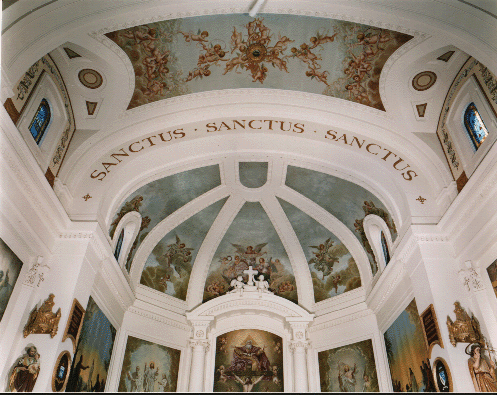
Mark Greschner MPA, Artec Photographic
Design
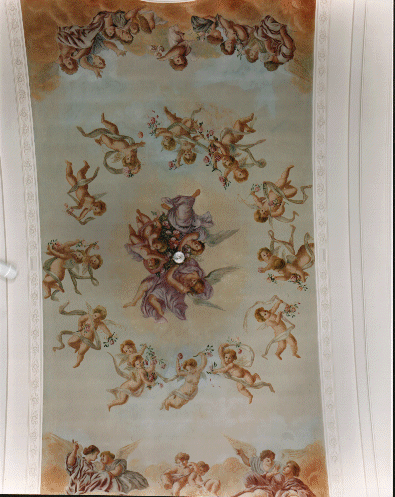

Mark Greschner MPA, Artec Photographic
Design

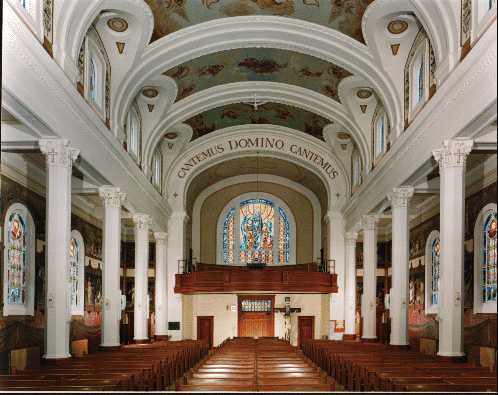
Mark Greschner MPA, Artec Photographic
Design
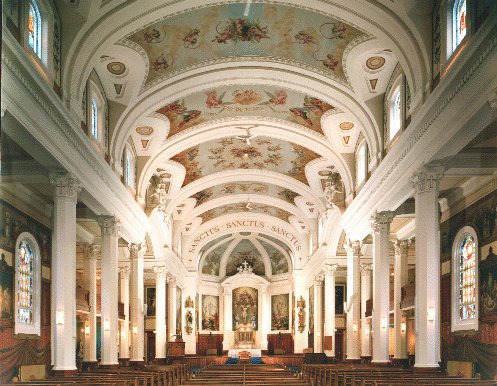
Mark Greschner MPA, Artec Photographic
Design

Mark Greschner MPA, Artec Photographic
Design
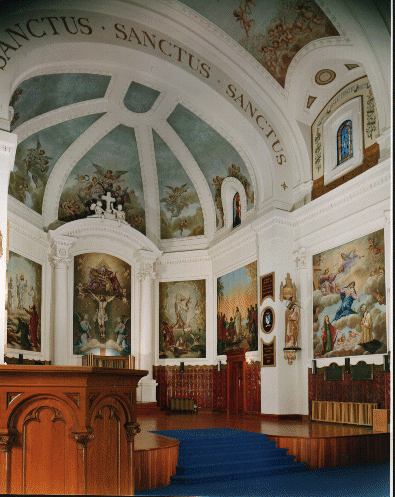
Mark Greschner MPA, Artec Photographic
Design
Quatrième niveau
des peintures, la voûte de la Co-Cathédrale
Tout ce qui se trouve au-dessus de la démarcation
blanche y inclus les neuf tableaux d’anges célestes et autour des
seize petits vitraux représentent, pour Msgr Charles Maillard -
le Ciel qui est déjà commencé sur terre. Il a écrit
sur la voûte de la Co-Cathédrale, le premier verset du Gloire
à Dieu « `«Gloria in Excelsis Deo - et in terra- Pax
-hominibus bonae voluntatis` Gloire à Dieu – au plus des cieux et
paix sur la terre aux hommes de bonne volonté. Sur le haut des petits
vitraux, il y a des citations latines. Il y en a une qui dit « `Pax
cum Deo` qui signifie «`Paix avec Dieu` et près de celle-ci,
deux autres citations disant `Pax cum proximo` et `Pax cum semetipso` signifiant
`Paix avec son prochain` et `Paix avec soi-même`. Dans ses tableaux,
Msgr Maillard, exprime que si nous vivons en harmonie avec les autres et
avec vous-même, nous vivons en harmonie parfaite avec Dieu.
Autour des petits vitraux de la voûte,
il a écrit le contraire des sept péchés capitaux –
il a écrit les vertus où se voient des plantes, des fleurs
et des fruits à profusion. «`Fleurs, épanouissez-vous
et donnez des fruits, dit l’inscription latine - `Florete flores` et `date
frvctvs`.
D’autres inscriptions en Latin sont comme
celles qui se trouvent au-dessus de la galerie de la chorale disant `Cantemus
Domino Cantemus` signifiant `Chantez au Seigneur, Chantez` et `Sanctus
! Sanctus ! Sanctus !` ces trois mots inscrits sur l’arche qui surplombent
l’entrée du sanctuaire, signifient `Saint ! Saint ! Saint !`.
(Afin de s’inspirer, Msgr Maillard utilisa
des photos de bébés et d’enfants de ses paroissiens. On nous
dit également que tous les anges qu’il fit peinturer étaient
nus. A cause de la pudeur et des commentaires de ses paroissiens, il décida
d’ajouter à ses peintures des rubans pour couvrir les anges.)
Fourth
level of paintings, the entire Co-Cathedral`s ceiling
All that is above
the pictorial life of Saint Philomena represents the fourth level of the
Co-Cathedral’s paintings. The nine ceiling paintings of celestial angels
and all the designs that surround the 16 smaller stained glass windows
represented for Msgr. Maillard that heaven begins on earth. He wrote on
the ceiling the first verse of the Glory to God «`Gloria in Excelsis
Deo – et in terra – Pax – hominibus bonae voluntatis` - Glory to God in
the highest and peace on earth and good will to all men. On the top of
a few smaller windows, there are Latin insricptions which read `Pax cvm
Deo` meaning `Peace with thy God` and two others reading `Pax cvm proximo`
and `Pax cvm semetipso` translated into English, this means `Peace with
thy neighbour` and ‘Peace with thyself`. Msgr. Maillard explains in his
paintings that if we live in perfect harmony with ourselves and with our
neighbours, we will live in perfect harmony with God.
Around the ceiling
windows, the priest-artist listed the Catholic Virtues which oppose the
Capital Sins written on the bottom level of the Co-Cathedral. `Florete
flores` and `date frvctvs` are two more Latin inscriptions, written above
the Virtues, meaning `Flowers, grow and give fruit`.
On the arch above
the choir loft is written `Cantemus Domino Cantemus` meaning `Sing to the
Lord, Sing` and on the principal arch before the sanctuary is written `Sanctus
! Sanctus ! Sanctus !` (Holy ! Holy ! Holy !).
(Msgr. Maillard was
often inspired by photographs of his parishioners’ babies and children
for the drawing of the celestial angels. It is told that the angels were
originally painted naked. A group of parishioners, having shared their
displeasure, encouraged Msgr. Maillard to paint ribbons over the angels.)


retour
back







